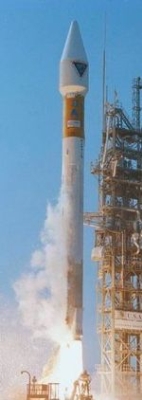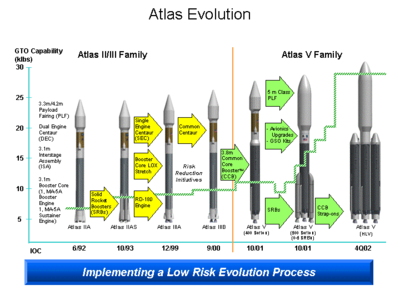
Atlas II
Encyclopedia
Atlas II was a member of the Atlas
family of launch vehicle
s, which evolved from the successful Atlas missile program of the 1950s. Atlas II was the last Atlas to use a three engine, "stage-and-a-half" design: two of its three engines were jettisoned during ascent, but its fuel tanks and other structural elements were retained. It was designed to launch payloads into low earth orbit, geosynchronous transfer orbit or geosynchronous orbit. Sixty-three launches of the Atlas II, IIA and IIAS models were carried out between 1991 and 2004. (The larger Atlas III
was used between 2000 and 2005, and the Atlas V
is still in use.)
– the world’s first high-energy propellant stage – to increase its payload capability. Atlas II also had lower-cost electronics, an improved flight computer and longer propellant tanks than its predecessor, Atlas I
.
The most powerful derivative was the Atlas IIAS.
(now Lockheed-Martin) to develop the Atlas II vehicle, primarily to launch Defense Satellite Communications System
payloads and for commercial users as a result of Atlas I launch failures in the late 1980s. Led by lead engineer Samuel Wagner, the Atlas II was crucial to the continued development of the United States' space program.
Atlas IIs were launched from Cape Canaveral Air Force Station
, Fla., by the 45th Space Wing. The final West Coast Atlas II launch was accomplished December 2003 by the 30th Space Wing, Vandenberg AFB, Calif.

Atlas (rocket family)
Atlas is a family of U.S. space launch vehicles. The original Atlas missile was designed in the late 1950s and produced by the Convair Division of General Dynamics, to be used as an intercontinental ballistic missile...
family of launch vehicle
Launch vehicle
In spaceflight, a launch vehicle or carrier rocket is a rocket used to carry a payload from the Earth's surface into outer space. A launch system includes the launch vehicle, the launch pad and other infrastructure....
s, which evolved from the successful Atlas missile program of the 1950s. Atlas II was the last Atlas to use a three engine, "stage-and-a-half" design: two of its three engines were jettisoned during ascent, but its fuel tanks and other structural elements were retained. It was designed to launch payloads into low earth orbit, geosynchronous transfer orbit or geosynchronous orbit. Sixty-three launches of the Atlas II, IIA and IIAS models were carried out between 1991 and 2004. (The larger Atlas III
Atlas III
The Lockheed Martin Atlas III was an American orbital launch vehicle, used between 2000 and 2005. It was the first member of the Atlas family since the Atlas A to feature a "normal" staging method, compared to the previous Atlas family members, which were equipped with jettisonable engines on the...
was used between 2000 and 2005, and the Atlas V
Atlas V
Atlas V is an active expendable launch system in the Atlas rocket family. Atlas V was formerly operated by Lockheed Martin, and is now operated by the Lockheed Martin-Boeing joint venture United Launch Alliance...
is still in use.)
Features
Atlas II provided higher performance than the earlier Atlas I by using engines with greater thrust and longer fuel tanks for both stages. The total thrust capability of the Atlas II of 490,000 pounds force (2,200 kN) enabled the booster to lift payloads of 6,100 pounds (2,767 kg) into geosynchronous orbit of 22,000 miles (35,000 km) or more. This series used an improved Centaur upper stageCentaur (rocket stage)
Centaur is a rocket stage designed for use as the upper stage of space launch vehicles. Centaur boosts its satellite payload to geosynchronous orbit or, in the case of an interplanetary space probe, to or near to escape velocity...
– the world’s first high-energy propellant stage – to increase its payload capability. Atlas II also had lower-cost electronics, an improved flight computer and longer propellant tanks than its predecessor, Atlas I
Atlas I
The Atlas I was an American expendable launch system, used in the 1990s to launch a variety of different satellites. The "I" in "Atlas I" can cause confusion, as all previous Atlas rockets were designated using letters, ending with the Atlas H, however subsequent rockets were designated using roman...
.
The most powerful derivative was the Atlas IIAS.
Background
In May 1988, the Air Force chose General DynamicsGeneral Dynamics
General Dynamics Corporation is a U.S. defense conglomerate formed by mergers and divestitures, and as of 2008 it is the fifth largest defense contractor in the world. Its headquarters are in West Falls Church , unincorporated Fairfax County, Virginia, in the Falls Church area.The company has...
(now Lockheed-Martin) to develop the Atlas II vehicle, primarily to launch Defense Satellite Communications System
Defense Satellite Communications System
The Defense Satellite Communications System provides the United States with military communications to support globally distributed military users. DSCS will be replaced by the Wideband Global SATCOM system. A total of 14 DSCS III satellites were launched between the early 1980s and 2003. Two...
payloads and for commercial users as a result of Atlas I launch failures in the late 1980s. Led by lead engineer Samuel Wagner, the Atlas II was crucial to the continued development of the United States' space program.
Atlas IIs were launched from Cape Canaveral Air Force Station
Cape Canaveral Air Force Station
Cape Canaveral Air Force Station is an installation of the United States Air Force Space Command's 45th Space Wing, headquartered at nearby Patrick Air Force Base. Located on Cape Canaveral in the state of Florida, CCAFS is the primary launch head of America's Eastern Range with four launch pads...
, Fla., by the 45th Space Wing. The final West Coast Atlas II launch was accomplished December 2003 by the 30th Space Wing, Vandenberg AFB, Calif.
- General Characteristics
- Primary function: Launch vehicle
- Primary contractor: Lockheed Martin - airframe, assembly, avionics, test and systems integration
- Principal subcontractors: Rocketdyne (Atlas engine, MA-5); Pratt & Whitney (Centaur engine, RL-10) and Honeywell & Teledyne (avionics)
- Power Plant: Three MA-5A Rocketdyne engines, two Pratt & Whitney RL10A-4 Centaur engines
- Thrust: 494,500 lbf (2,200 kN)
- Length: Up to 156 ft (47.54 m); 16 ft (4.87 m) high engine cluster
- Core Diameter: 10 feet (3.04 m)
- Gross Liftoff Weight: 414,000 lb (204,300 kg)
- First Launch: February 10, 1992
- Models: II, IIA, and IIAS
- Launch Site: Cape Canaveral AFSCape Canaveral Air Force StationCape Canaveral Air Force Station is an installation of the United States Air Force Space Command's 45th Space Wing, headquartered at nearby Patrick Air Force Base. Located on Cape Canaveral in the state of Florida, CCAFS is the primary launch head of America's Eastern Range with four launch pads...
, FloridaFloridaFlorida is a state in the southeastern United States, located on the nation's Atlantic and Gulf coasts. It is bordered to the west by the Gulf of Mexico, to the north by Alabama and Georgia and to the east by the Atlantic Ocean. With a population of 18,801,310 as measured by the 2010 census, it... - Inventory: unavailable


